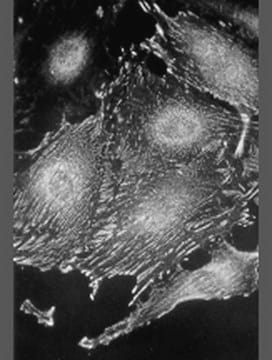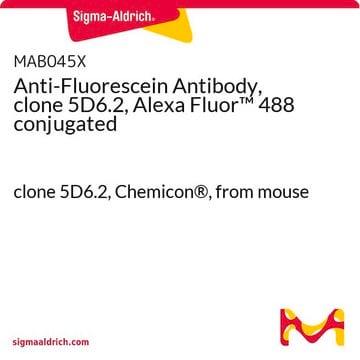11333089001
Roche
Anti-Digoxigenin
from sheep
Synonyme(s) :
anti-digoxigenin, digoxigenin
Se connecterpour consulter vos tarifs contractuels et ceux de votre entreprise/organisme
About This Item
Code UNSPSC :
12352203
Produits recommandés
Source biologique
sheep
Niveau de qualité
Conjugué
unconjugated
Forme d'anticorps
purified immunoglobulin
Type de produit anticorps
primary antibodies
Clone
polyclonal
Forme
lyophilized
Conditionnement
pkg of 200 μg
Fabricant/nom de marque
Roche
Isotype
IgG
Température de stockage
2-8°C
Description générale
Digoxigenin is a hapten which is used in labeling of nucleic acids and in detection systems.
Probes labeled with digoxigenin has greater sensitivity equivalent to that of radioactive probes. It allows faster detection, is less hazardous and has an increased shelf life.
Spécificité
The polyclonal antibody from sheep is specific to digoxigenin and digoxin and shows no cross-reactivity with other steroids, such as human estrogens and androgens.
Application
Anti-Digoxigenin has been used in DNA tethering. It has been used to attach DNA molecule to the glass surface of the flow cell.
Use Anti-Digoxigenin antibody for the detection of digoxigenin-labeled compounds using:
- ELISA
- Immunohistocytochemistry
- In situ hybridization
- Western blot
Actions biochimiques/physiologiques
In the presence of Na+, Mg2+ and ATP, digoxigenin inhibits sodium pumps.
Notes préparatoires
Working concentration: Working concentration of antibody depends on application and substrate. The following concentrations should be taken as a guideline:
Working solution: For coating applications: PBS (phosphate buffered saline), pH 7.4
- ELISA: for coating: 2 to 4 μg/ml
- Immunohistocytochemistry: 0.5 to 2 μg/ml
- In situ hybridization: 0.2 to 0.4 μg/ml
- Western blot: 0.5 to 2 μg/ml
Working solution: For coating applications: PBS (phosphate buffered saline), pH 7.4
After immunization with digoxigenin, sheep IgG was purified by ion-exchange chromatography, and the specific IgG was isolated by immunosorption.
Reconstitution
Add 1 ml PBS to a final concentration of 200 μg/ml.
Remarque sur l'analyse
No cross reactivity with other steroids, such as human estrogens e.g., estradiol or androgens e.g., testosterone.
Autres remarques
For life science research only. Not for use in diagnostic procedures.
Vous ne trouvez pas le bon produit ?
Essayez notre Outil de sélection de produits.
Mention d'avertissement
Warning
Mentions de danger
Conseils de prudence
Classification des risques
Skin Sens. 1
Code de la classe de stockage
11 - Combustible Solids
Classe de danger pour l'eau (WGK)
WGK 3
Point d'éclair (°F)
does not flash
Point d'éclair (°C)
does not flash
Faites votre choix parmi les versions les plus récentes :
Déjà en possession de ce produit ?
Retrouvez la documentation relative aux produits que vous avez récemment achetés dans la Bibliothèque de documents.
Les clients ont également consulté
Chan Chen et al.
Aging, 12(14), 14490-14505 (2020-07-22)
Cardiac arrest (CA) is the leading cause of death around the world. Survivors after CA and cardiopulmonary resuscitation (CPR) develop moderate to severe cognitive impairment up to 60% at 3 months. Accumulating evidence demonstrated that long non-coding RNAs (lncRNAs) played
Pengyu Hao et al.
Proceedings of the National Academy of Sciences of the United States of America, 117(30), 17775-17784 (2020-07-17)
DNA mismatch repair (MMR), the guardian of the genome, commences when MutS identifies a mismatch and recruits MutL to nick the error-containing strand, allowing excision and DNA resynthesis. Dominant MMR models posit that after mismatch recognition, ATP converts MutS to
Juliette Salvaing et al.
PloS one, 7(5), e38156-e38156 (2012-06-14)
In the mouse zygote, DNA methylation patterns are heavily modified, and differ between the maternal and paternal pronucleus. Demethylation of the paternal genome has been described as an active and replication-independent process, although the mechanisms responsible for it remain elusive.
Electron paramagnetic resonance of a single NV nanodiamond attached to an individual biomolecule.
Teeling-Smith R M, et al.
Biophysical Journal, 110(9), 2044-2052 (2016)
Affinity Labeling of a Sulfhydryl Group in the Cardiacglycoside Receptor Site of Na+/K+?ATPase by N?Hydroxysuccinimidyl Derivatives of Digoxigenin.
Antolovic R, et al.
European Journal of Biochemistry, 227(1?2), 61-67 (1995)
Notre équipe de scientifiques dispose d'une expérience dans tous les secteurs de la recherche, notamment en sciences de la vie, science des matériaux, synthèse chimique, chromatographie, analyse et dans de nombreux autres domaines..
Contacter notre Service technique







